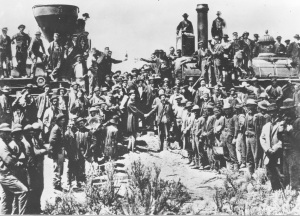Post 10: Railroaded
Richard White opens his book Railroaded: The Transcontinentals and the Making of Modern America with a problem relating to the various groups building railroads across the west: various track sizes that do not match. That had to be confusing and frustrating when attempting trade or travel. (pg. 2). If that was a beginning problem of the railroads in the late 1800’s, many more problems are sure to follow. The main problem which White focuses on is the corrupt companies, corporate failures and mistakes of building railroads across Canada, Mexico and the US. I am really surprised that with so many problems that most of the railroad systems created in the late 1800s survived into what we know today. The intense competition and politics between the various western railroads complicated people’s lives and created reasons for bribery to many politicians.
There was a recent article on NPR which stated that there are many farmers with grain, corn and soybeans waiting for the train, but the trains are all tied up in oil productions further north into the Dakotas. This is a very similar situation to the production and need for transportation which White addresses in his book. White noted that many people moved out west where the railroad was built to begin a farm and use the modern transportation to move goods. Unfortunately, eventually the goods failed and the people moved away, creating an area which the railroad still moved through but did not create money as there were no good to take to market, in turn costing the railroad company money with no profit. Though during the late 1800s if more trains were needed they just built more, unlike today and the more complex routes of passenger and freight trains. Over the years many railroads have shifted their routes to move the most goods, but as this story states the railroads are needed further south for the grain and bean productions.
I enjoyed the more personal stories he told within the end of chapters sections in “A Railroad Life”. These small sections expanded on some ideas and gave more details to the overall story. Richard White makes a very interesting point on page 317, with his discussion about photographs and how it freezes time and doesn’t give the whole story. Historians need to remember that some photographs are staged and usually photographs do not include all the people of a specific story. The example relating to this book would be the famous picture of “The Last Spike” driven to connect the railroads in Utah. The historical picture from 1869 shows many of the workers and conductors celebrating, but is missing a large demographic of the other railroad workers…the Chinese.
(National Archives 594940)
A modern historian recently recreated the scene with some of the descendants of the Chinese railroad workers. This story can also be found on NPR.


Great post–I especially liked how you linked to that fascinating NPR story on the descendants of Chinese railroad workers. Stanford is currently doing a project to try to recover their voices: — here is an article about that project: http://www.educause.edu/ero/article/chinese-railroad-workers-america-project. A lot of stories yet to be told…
Hey Megan, interesting post. I think White would add to your point about “just building more” that it didn’t really matter if there was a need for a railroad or not; the railroad men built one anyway. In fact, it seems that many of the tracks laid during this period were not built to meet any sort of demand but only to fulfill the entrepreneur’s get-rich scheme. Also, based on your blog post here and some of your comments in class, it seems that you are interested in photography and particularly photos as historical evidence. If you haven’t already read Errol Morris’ “The Case of the Inappropriate Alarm Clock”, then I would highly recommend it. It is a great article (or series) that wrestles with these ideas of authenticity and historical objectivity as they relate to photos. And it is a fun and interesting piece. http://opinionator.blogs.nytimes.com/2009/10/18/the-case-of-the-inappropriate-alarm-clock-part-1/?_r=0